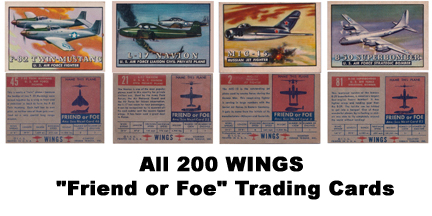
Aviation Through the Eyes of Kids in the Mid-1950s
Trading Cards and Turkish Airplanes

The Wings card series consists of 200 aircraft subjects: color paintings of planes of late 1940s and early 1950s vintage. The paintings were produced from photographs supplied by the New York Herald Tribune. The set has been assigned American Card Catalog number R707-4. Wings cards were issued in Penny or Nickel packs that included on (or five) trading cards and some particularly noxious bubble gum.
.When we still lived in the City (1952-1953) I, along with nearly every othe boy got caught up in Trading Card Fever. This was not serious collecting but rather, a form of gambling. The idea was to acquire a huge wad of trading cards through a number of "games". It started with "matching" -- Player "A" would flip a card so that it turned over at least three times. When it landed, the Player "B" would announce his intent to "match" or "not match" the card. If the prophecy proved correct, Player "B" would win the card, otherwise Player "A" would win. This binary game held interest for a while, but a whole recess period invested in "matching" would probably leave you just where you started. I don't believe that anyone developed the manual dexterity to control the behavior of the card, although there were numerous individual styles. Young Boys rediscover Capitalism very quickly, especially the principle of "no risk, no reward." Thus games with longer odds evolved ("Best three out of Five"), but still did not offer the kind of rewards that provided thrills.
Then one day, a new game evolved. It was called "Flipping" -- in this case,, Players "A" and "B" climbed onto something that put them about eight feet off the ground. The playground slide was afavorite as well as fire escapes or even trees. The players took turns flipping cards from the perch. A "match" was over when one of the cards landed atop another. The person who had "covered" one of his opponents' cards would collect all the cards on the ground. (Generally, this duty was entrusted to a close friend, so that time would not be wasted climbing up and down the fire escape. The other rule covered defaults -- if a player ran out of cards, he forfeited. On a windy day, 20-30 cards might be on the ground. If you could get to a second story window, hundreds of cards could change hands. The possibility for a big win attracted even Girls. For a while, every kid was carrying a cigar box full of cards and the gossip ofthe day was about who "cleaned out" who.
I lost a bunch of cards at this, and, suitably chastened, developed another line -- that of Banker. It started when Jimmy Manning, the toughest kid on the block, had about 75 cards in the game and ran out. He turned to me and asked for the loan of a few cards. In a moment of inspiration, I said "Two for Three" meaning that I would advance him cards expecting a 50% interest. At those rates, it was not long before I had a gigantic wad of cards. In those days, there was not much distinction about the type of card -- baseball, auto, airplane and boxing cards all mixed together -- the unit of value was "the card". It did not take long to discover rarities -- the Pittsburgh Pirates had a pitcher named Harvey Haddix who was [then] the only player in the National League to wear glasses. I assume that not many of those cards were made, since Haddix was far from star quality. However, people started believing that "The Guy With The Glasses" was lucky. Also, people wanted cards with special favorites like Ralph Kiner and Hank Greenberg to take to Forbes Field where all the ballplayers dutifuly signed things for kids. Harvey could be exchanged for three nondescript cards and Kiner got five to ten. By observing this, my stash grew even further. I even had competition -- one guy offered "five for four" but he was a poor judge of character and soon got stiffed into trading card bankruptcy. This did not happen to me because I had made a deal with Jimmy Manning to act as a sort of "enforcer." Word of this got around to the Men Who Hung Out At The Corner who were amused by my shylocking and gave me a greeting as I walked to school with my friends. This was certainly a boost to my social standing. Even Patricia Kumper, the ice princess of the fourth grade, suddenly knew my name. Then the fad blew over as soon as it started, and that was probably good because I didn't want to have to get the kiddie equivalent of an armored car. I think that my activities may have been the leading cause of my Mother's frantic desire to move to the Far Suburbs.
Left with a few cigar boxes full of useless cards and a small mountain of that terrible Topps gum, I got some solace out of organizing the cards by subject. I was most fascinated by the Wings cards because I was really into Model Airplanes. I think that the Wings cards were the LEAST liked by my clients because that's what they paid me off in. I was able to put together a complete set of the first 100 or so cards pretty easily.
You'll see that the cards have a picture of an airplane on the front and on the back is a little description of the plane and a "tri-view" silhouette. You were asked to identify the silhouette but had to get the next card in the series to find the answer. So, the paradigm was the answer to the question on card "N" is the plane on card "N+1" The last card in the series would point back to Card #1. In fact, the paradigm holds true for the first 100 cards (the answer for Card 100 is Card no. 1). However, other cards began to appear with numbers higher than 100. In this case, the answer was to be found on a card far ahead in the series. For example, the answer for Card 102 is found on Card 121 and the answer for Card 103 is found on Card 115.
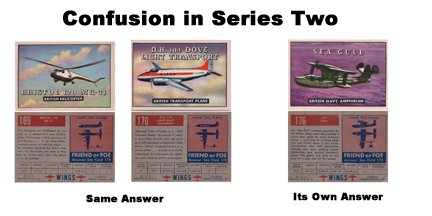
Left: Cause Right: Effect
As shown above, Card No. 169 and Card 170 have the same question. Those among you who have studied Combinatorial Analysis know that this will yield only 99 choices for the answer to 100 questions. Those of you who pay attention to detail will see that Card No. 176 is the answer to its own question. In addition to statistical anomalies, the second set suffers from poorer quality printing - most of the cards are off-register and the image is about 1/16" wider than in Series One .
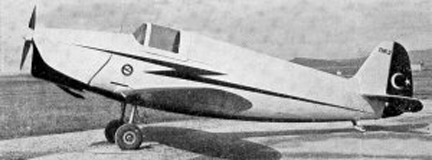
T.H.K Model Two
T.H.K is the abbreviation for Türk Hava Kurumu ("Turkish Airplane Company")
Bearing witness to the titanic struggle between the USA and the USSR, Series Two offers a peep at an "Unknown" Russian plane (Card No 135). Howver, the subjects of Series Two are pretty mundane, including a lot of helicopters.
By 1956, NATO had become much more prominent and thus there are salutes to our Allies including Spain, the Netherlands, Sweden, Italy, and Czechoslovakia. Included in this category is the the notorious Card No. 199 - the Turkish Plane. (For purists, it is the T.H.K-2, a Turkish trainer that looks like a Piper Cub.) They must have had second thoughts about it because they didn't make many of them. In 1957 or thereabouts, the price of the Turkish Plane was three Hank Greenbergs, something that I did not wish to pay, so I chewed a lot of that horrible bubble gum. But, I eventually acquired a complete set, which I carried through more than 50 years of travel. I am now very pleased to share it with you.
SLIDE SHOW
View a SLIDE SHOW of All 200 Cards
It takes a long time to load but it's worth it...INDIVIDUAL CARDS
Click on a thumbnail to see an enlarged view of the card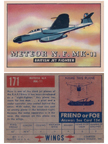
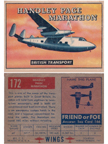
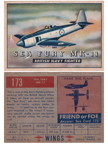
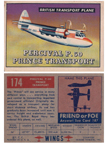
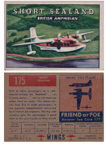
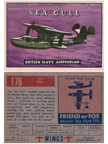
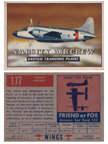
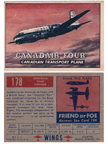
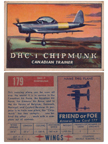
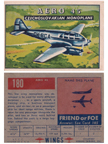
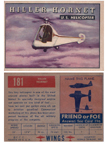
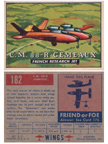
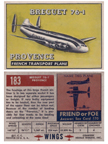
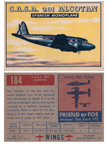

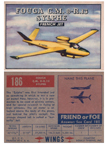
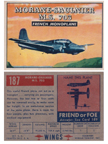
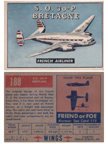
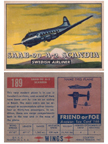

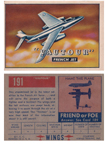
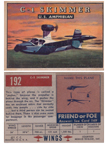
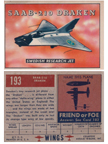


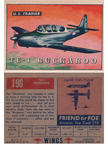
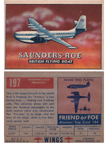
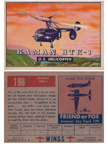
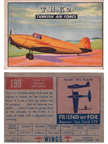
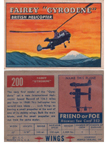
For those of you who don't like buttons, here is a list by number and subject.
- T-33
- MIG 15
- XC-120 Pack Plane
- Lincoln
- P-51 "Mustang"
- AT-7 (C-45)
- PBY "Catalina"
- B-26 "Invader"
- XF-91
- F-7U "Cutlass"
- Vampire
- B-57 C"Canberra"
- Short "Sunderland"
- PB4Y-2 "Privateer"
- T-28
- Wyvern Mk 2
- Balliol T. Mk. 2
- P-47 "Thunderbolt"
- HUP-1
- Hermes
- L-17 "Navion"
- F3D "Skyknight"
- A.M. "Mauler"
- B-36
- F8F Bearcat
- P-80 "Shooting Star"
- Sea Attacker
- F6F "Hellcat"
- P2V "Neptune"
- AVRO Jetliner
- C-121 "Constellation"
- C-74 "Globemaster"
- F84F
- F4U "Corsair"
- Firefly
- C-125 "Raider"
- C-46 "Commando"
- PE-2
- AF "Guardian"
- C-82 "Packet"
- R-60 "Constitution"
- IL-12
- "Hastings"
- AJ "Savage" Composite
- T82 "Twin Mustang"
- X54D "Skyray"
- T-6 "Texan"
- C-123 "Avitruk"
- JRM "Mars"
- "Meteor"
- B-29 "Superfortress"
- IL-10
- B-45 "Tornado"
- LA-5
- "Comet"
- H-13D
- PE-8
- C-97 "Stratofreighter"
- H-21
- FH-1 "Phantom"
- B-47 "Stratojet"
- L-20 "Beaver"
- FJ "Fury"
- F-94 "Starfire"
- "Shackleton"
- S-51
- A-20 "Havoc"
- IL-2 Stormovik
- C-119 "Packet"
- C-54
- F086 "Sabre"
- "Venom"
- M-19
- TBM "Avenger"
- CF-100 "Canuck"
- F-84 "Thunderjet"
- F86-D
- "Sea Hawk"
- SA-17 "Albatross"
- Martin 202
- B-50 "Superbomber"
- Convair-240 (T-29)
- "Ambassador"
- IL-4
- "Viscount"
- B-25 "Mitchell"
- YAK-3
- C-47 "Skytrain"
- A-20 "Skyhawk"
- F-89 "Scorpion"
- IL-16
- P5M "Marlin"
- H-12
- F-7F "Tigercat"
- F-2H "Banshee"
- P-4M "Mercator"
- C-124 "Globemaster
- TU-4
- YAK-15
- F-9F "Panther"
- AE-27 "Pulqui"
- AE33 "Pulqui II"
- O.10 "Leduc"
- M.D. 450 "Ouragan"
- S.O. 6021 "Espadon"
- S.O. M2
- S.O. 6000 "Triton"
- VG-90
- NORD 1601
- NORD 2260
- 707A Delta Wing
- AVRO "Ashton"
- Supermarine 535
- Vickers 600 "Valiant"
- Hawker P-1081
- Short S.B.3
- Handley-Page 88
- Radio Controlled Target Plane
- Fokker S-14
- MIG-19
- SAAB 29-A
- F9-F "Cougar"
- YB-60
- XF-88A "Voodoo"
- F-84G "Thunderjet"
- XC-99
- XC-123A "Avitruk"
- X-4
- PO-1W (Modified Constellation)
- S.E. 2415 "Gronard II)
- Supermarine S41 "Swift"
- Gloster GA-5
- SP-A/I
- Short S-A/4
- "Unknown"
- X A2J-1 "Savage" Composite
- FJ-2 North American
- AD-5 "Skyraider"
- PBM-5 "Mariner"
- XP5Y-1 Vultee
- TO-2 Lockheed
- XF-92A Vultee
- XF3H-1 "Demon"
- DC-6A "Liftmaster"
- YRB-49A "Flying Wing"
- Target II
- D.H. "Sea Hornet"
- DH 112 "Venom"
- XH-26
- FIAT G.80
- YB-1 Blackburn
- XF-90
- MK-3 Bristol 171
- Saro-Cierva
- Sikorsky H.C. MK-2 "Dragonfly"
- S.O. 1120 "Ariel III"
- Breguet Type III Gyroplane
- LZ 1A
- G.C.A. Model 2
- Hiller 360
- MC-4
- M-14
- YH-18
- HO 45-1
- Boulton-Pau; P-111
- Avro "Athena" T. Mk-2
- Avro Anson T. Mk. 20
- Blackburn "Firebrand"
- Bristol 170 Mk-31
- D.H. 104 "Dove"
- Meteor N.F. MK-11
- Handley Page "Marathon"
- "Sea Fury" MK-II
- Percival P-50 "Prince"
- Short "Sealamd"
- "Sea Gull"
- Varsity Aircrew
- Canadair Four
- DHC-1 "Chipmunk"
- AERO 45
- Hiller "Hornet"
- C.M 88-R "Gemaux"
- Breguet 76-1 "Provence"
- C.A.S.A. 201 "Alcotan"
- Douglas "Skyrocket"
- Fouga.M. B-R13 "Sylphe"
- Morane-Saulnier M.S. 703
- S.O. 30-P "Bretagne"
- SAAB -90 A2 "Scandia"
- Beechcraft D-185
- "Vautour"
- C-1 "Skimmer"
- SAAB-210 "Draken"
- CF-100 "Canuck"
- Mooney M-18L "Mite"
- TE-1 "Buckaroo"
- Saunders-Roe "Princess"
- Kaman HTK-1
- T.H.K-2
- Fairey "Gyrodene"
Counter for the ENTIRE WEBSITE
Home | About Lindy | 1940s Collectibles | Upcoming Events | Vintage Clothing
The Guide - Establishments - Travel - Accessories
Music | Links | Photo Gallery | Extras | Contact